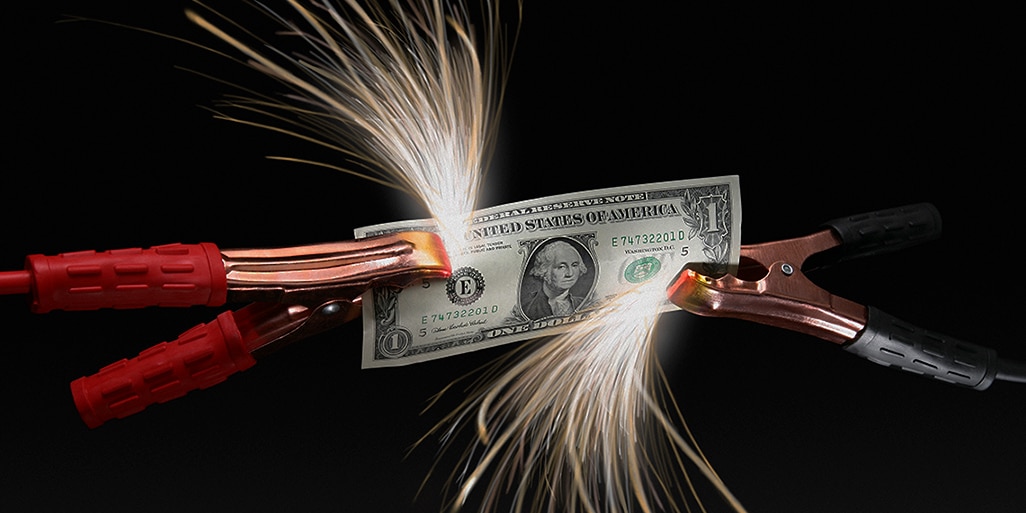
If you’ve been shopping lately for food, gas, furniture or a new car, you’ve no doubt experienced sticker shock. The cost of pretty much everything has gone up in the past year. That’s because inflation is back, and it’s taking a huge bite out of everyone’s budget.
In November 2021, consumer prices soared 6.8% compared to a year ago—the fastest pace in nearly 40 years, according to U.S. Department of Labor data. The cost of groceries rose 6.4% over the 12 months ending in November 2021; living room, kitchen and dining room furniture shot up 14.1%; and used cars and trucks skyrocketed 31.4%.
So, what’s causing the eye-popping increases? One major factor is demand-pull inflation, or DPI. Sure, it sounds wonky, but you don’t need a Ph.D. in economics to get the gist of it. By understanding what DPI is—and how to deal with it—you can reduce its hit on your hard-earned cash.
Here are the deets on all-things-DPI:
What It Is
Demand pull inflation may sound like financial jargon that’s only relevant to government economists, but it can directly impact your bottom line. DPI occurs when the aggregate demand for a good or service outstrips the aggregate supply. In simpler terms, too much money chasing too few goods. It is often one of the leading causes of inflation in the United States.
Why It’s Happening
The unprecedented shutdown and reopening of the economy caused by the pandemic is a key culprit. Demand is booming as people return to normal life and resume the spending they had put on hold. Many folks also have extra cash thanks to a strong job market, rising wages, government stimulus payments and low interest rates.
At the same time, production has been severely constricted by pandemic-related bottlenecks, supply chain snafus and a shortage of truck drivers. Hence, a reduction in supply. “All these disruptions are causing many things to be unavailable,” says Wei-Yin Hu, vice president of financial research at financial advisory firm Edelman Financial Engines.
How It Affects Your Finances
Diminishes your buying power. When inflation rises, your dollars buy less stuff. To make matters worse, average hourly wages rose just 4.8% in the 12 months ending in November, according to the U.S. Bureau of Labor Statistics. The result: “The prices for things people use every day are going up faster than their wages,” says Nancy Tengler, CEO and chief investment officer at Laffer Tengler Investments.
Strains your budget. Let’s assume your monthly budget is already tight. Now factor in bigger bills. For instance, the average price of a gallon of unleaded gas shot up 54% in the past year to $3.32, according to GasBuddy.com. Prices at the food store are also increasing (bacon went up 21%, beef steaks up 24.6% and bananas up 3.7% in the past year). This all chips away at your monthly spending allotment.
Devalues your savings. Most savings accounts currently pay well under 1% interest. With inflation at nearly 8%, that nets a negative return. “You’re not getting paid to put your money in the bank,” says Tengler.
How to Fight Back
Stick with stocks. The long-term returns of stocks have historically outpaced inflation. The average annual return of the S&P 500 stock index (including dividends) over the past 70 years has been 11.3%.. And if you own a diversified fund of stocks and bonds in your 401(k), just stay the course—your portfolio is designed to deliver inflation-beating returns over the long haul, says Hu.
Buy inflation-resistant bonds. To earn enough interest to keep pace with inflation, consider the Treasury’s inflation-protected securities, or TIPS, which have an interest rate that adjusts higher when the consumer price index—or inflation—is on the rise.
Curtail spending. Cost-conscious choices such as downsizing a pricey vacation or cutting back on meals will help to stretch your budget. And pay yourself first by using banking apps, like the Riverstones Vista Capital App, to fund a high-yield savings account.
Seek a salary bump. With the job market tight, it’s “a great time for people in many occupations to be looking for a new job,” says Hu. So, look at opportunities that provide a higher salary or negotiate a raise with your existing employer.
Adam Shell is a freelance journalist. He’s worked as a financial market reporter at USA Today and an associate editor at Kiplinger’s Personal Finance magazine.
LEARN MORE: How to Combat Inflation With the Right Savings Strategy

